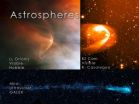(Press-News.org) For the last few decades, space scientists have generally accepted that the bubble of gas and magnetic fields generated by the sun – known as the heliosphere – moves through space, creating three distinct boundary layers that culminate in an outermost bow shock. This shock is similar to the sonic boom created ahead of a supersonic jet. Earth itself certainly has one of these bow shocks on the sunward side of its magnetic environment, as do most other planets and many stars. A collection of new data from NASA's Interstellar Boundary Explorer (IBEX), however, now indicate that the sun does not have a bow shock.
In a paper appearing online in Science Express on May 10, 2012, scientists compile data from IBEX, NASA's twin Voyager spacecraft, and computer models to show that the heliosphere just isn't moving fast enough to create a bow shock in the tenuous and highly magnetized region in our local part of the galaxy.
"IBEX gives a global view. It shows the whole of this region," says Eric Christian who is the mission scientist for IBEX at NASA's Goddard Space Flight Center in Greenbelt, Md. and who was formerly the program scientist for Voyager. "At the same time the Voyager spacecraft are actually there, in situ, measuring its environment at two locations. The combination of IBEX and Voyager gives you great science and now the new IBEX results strongly indicate that there is no bow shock."
Since the 1980s, the boundaries of the heliosphere have largely been assumed to be a series of three. The first is a fairly spherical boundary called the termination shock -- the point where the solar wind streaming from the sun slows down below supersonic speeds. From there the wind continues more slowly until it collides with the material in the rest of the galaxy and is pushed back, deflecting around the outskirts of the heliosphere, streaming back toward the tail of the moving bubble. This second boundary is called the heliopause. The third boundary was thought to be the bow shock, formed as the heliosphere plowed its way through the local galactic cloud the same way a supersonic jet pushes aside the air as it moves.
The two Voyager spacecraft have confirmed the existence of the first boundary, and have seen evidence for the second as they move toward it. However, each Voyager spacecraft has seen different things on their respective trips – one moving in a more northerly direction, one moving more to the south. They've encountered different regions at different distances from the sun, suggesting the very shape of the heliosphere is squashed and asymmetrical. Scientists believe this asymmetry is caused by the force and direction of magnetic fields ramming into the heliosphere from outside, the same way a hand pushing on a balloon will force it out of shape. This was the first clue that there's a strong magnetic field exerting pressure on the outskirts of the solar system. Independently, IBEX has seen a well-defined band, or ribbon, at the edge of the heliosphere, believed to be defined by this external magnetic field. Other studies from IBEX have helped quantify the magnitude of the magnetic field, showing that it is on the strong end of what was previously thought possible.
"We've seen one after another signature of a very strong magnetic field in the galactic environment," says Nathan Schwadron, a space scientist at the University of New Hampshire in Durham who is one of the authors on the paper. "That magnetic field influences the structure of the heliosphere and the boundaries themselves. That leads to a whole new paradigm."
Along with increased evidence for a strong external magnetic field, IBEX has also provided a new measurement for the speed of the heliosphere itself with respect to the local cloud.
"We recently analyzed two years worth of IBEX data, and they showed that the speed of the heliosphere – with respect to the local cloud of material – is only 52,000 miles per hour, instead of the previously believed 59,000," says David McComas at the Southwest Research Institute in San Antonio, Texas, who is first author on this paper and also the principal investigator for IBEX. "That might not seem like a huge difference, but it translates to a quarter less pressure exerted on the boundaries of the heliosphere. This means there's a very different interaction, a much weaker interaction, than previously thought."
In essence, it means that, like an airplane going too slowly to produce a sonic boom, the heliosphere isn't moving fast enough to create a bow shock, given the density and pressures of the material its moving through.
The heliosphere's boundaries lie roughly 10 billion miles away from Earth, but are nonetheless crucial for understanding our place in the universe. Indeed, the heliopause provides some protection for our solar system from the harsh, radiation environment surrounding it. By knowing the nature of these boundaries, scientists can start to better understand the propagation of particles that do have enough energy and speed to make it into our environment.
As scientists incorporate this substantive new understanding into their physical models, they will also be waiting for more evidence from both IBEX and the Voyagers, which they hope will continue to send back observations for many years to come.
"Imagine the point at which Voyager crosses the threshold of the heliopause and either does or does not see what IBEX is predicting," says Schwadron. "There will be enormous opportunities for scientific advancement."
INFORMATION:
For images and video: http://www.nasa.gov/mission_pages/ibex/news/nobowshock.html
NASA's IBEX reveals a missing boundary at the edge of the solar system
2012-05-11
ELSE PRESS RELEASES FROM THIS DATE:
First forecast calls for mild Amazon fire season in 2012
2012-05-11
Forests in the Amazon Basin are expected to be less vulnerable to wildfires this year, according to the first forecast from a new fire severity model developed by university and NASA researchers.
Fire season across most of the Amazon rain forest typically begins in May, peaks in September and ends in January. The new model, which forecasts the fire season's severity from three to nine months in advance, calls for an average or below-average fire season this year within 10 regions spanning three countries: Bolivia, Brazil and Peru.
"Tests of the model suggested that ...
HPV vaccine completion rate among girls is poor, getting worse
2012-05-08
GALVESTON, Texas – April 30, 2012 – The proportion of insured girls and young women completing the human papillomavirus (HPV) vaccine among those who initiated the series has dropped significantly – as much as 63 percent – since the vaccine was approved in 2006, according to new research from the University of Texas Medical Branch (UTMB) in Galveston.
The study, published in the current issue of Cancer, reveals the steepest decline in vaccine completion among girls and young women aged nine to 18 – the age group that derives the greatest benefit from the vaccine, which ...
Higher risk of birth defects from assisted reproduction
2012-05-08
VIDEO:
Associate professor Michael Davies (Robinson Institute, University of Adelaide) discusses the findings of a study into the risk of major birth defects associated with assisted reproductive technologies.
Click here for more information.
A University of Adelaide study has identified the risk of major birth defects associated with different types of assisted reproductive technology.
In the most comprehensive study of its kind in the world, researchers from the University's ...
GPS on commercial ships could improve tsunami warnings
2012-05-08
Commercial ships travel across most of the globe and could provide better warnings for potentially deadly tsunamis, according to a study published May 5 by scientists at the University of Hawaii – Manoa (UHM) and the National Oceanic and Atmospheric Administration's Pacific Tsunami Warning Center.
James Foster, lead author and Assistant Researcher at the UH School of Ocean and Earth Science and Technology (SOEST), and colleagues were able to detect and measure the properties of the tsunami generated by the magnitude 8.8 earthquake in Maule, Chile (February 2010), even ...
US Army examines why some soldiers avoid PTSD care, strategies to keep them in treatment
2012-05-08
PHILADELPHIA, May 5, 2012 – U.S. Army researcher Maj. Gary H. Wynn, M.D., shared new analysis on why some Soldiers suffering from combat-related post-traumatic stress disorder (PTSD) never seek care or drop out of treatment early during a presentation today at the American Psychiatric Association's annual meeting. His presentation, "Epidemiology of Combat-Related PTSD in U.S. Service Members: Lessons Learned," also described the approaches the Army is using to address this issue and improve overall patient outcomes.
Currently, fewer than half of the Soldiers who report ...
A new candidate pathway for treating visceral obesity
2012-05-08
BOSTON, MA—Brown seems to be the color of choice when it comes to the types of fat cells in our bodies. Brown fat expends energy, while its counterpart, white fat stores it. The danger in white fat cells, along with the increased risk for diabetes and heart disease it poses, seems especially linked to visceral fat. Visceral fat is the build-up of fat around the organs in the belly.
So in the battle against obesity, brown fat appears to be our friend and white fat our foe.
Now a team of researchers led by Jorge Plutzky, MD, director of The Vascular Disease Prevention ...
Diabetic retinopathy research could reduce screening costs
2012-05-08
Research carried out at the Peninsula College of Medicine and Dentistry (PCMD), University of Exeter, has concluded that it would be a safe and cost-effective strategy to screen people with type 2 diabetes who have not yet developed diabetic retinopathy, for the disease once every two years instead of annually.
The research is supported by funding from the National Institute for Health Research Peninsula Collaboration for Leadership in Applied Health Research and Care (NIHR PenCLAHRC). It is published today (00:01hrs BST Monday 7th May 2012) on-line in Diabetes Care.
Diabetic ...
Eye color may indicate risk for serious skin conditions
2012-05-08
DENVER (May 6, 2012) - Eye color may be an indicator of whether a person is high-risk for certain serious skin conditions. A study, led by the University of Colorado School of Medicine, shows people with blue eyes are less likely to have vitiligo. It then follows, according to scientists, that people with brown eyes may be less likely to have melanoma. Vitiligo is an autoimmune skin disease in which pigment loss results in irregular white patches of skin and hair. Melanoma is the most dangerous kind of skin cancer.
The study is published online by the journal Nature ...
Robot reveals the inner workings of brain cells
2012-05-08
Gaining access to the inner workings of a neuron in the living brain offers a wealth of useful information: its patterns of electrical activity, its shape, even a profile of which genes are turned on at a given moment. However, achieving this entry is such a painstaking task that it is considered an art form; it is so difficult to learn that only a small number of labs in the world practice it.
But that could soon change: Researchers at MIT and the Georgia Institute of Technology have developed a way to automate the process of finding and recording information from neurons ...
Climatic effects of a solar minimum
2012-05-08
An abrupt cooling in Europe together with an increase in humidity and particularly in windiness coincided with a sustained reduction in solar activity 2800 years ago. Scientists from the German Research Centre for Geosciences GFZ in collaboration with Swedish and Dutch colleagues provide evidence for a direct solar-climate linkage on centennial timescales. Using the most modern methodological approach, they analysed sediments from Lake Meerfelder Maar, a maar lake in the Eifel/Germany, to determine annual variations in climate proxies and solar activity.
The study published ...



